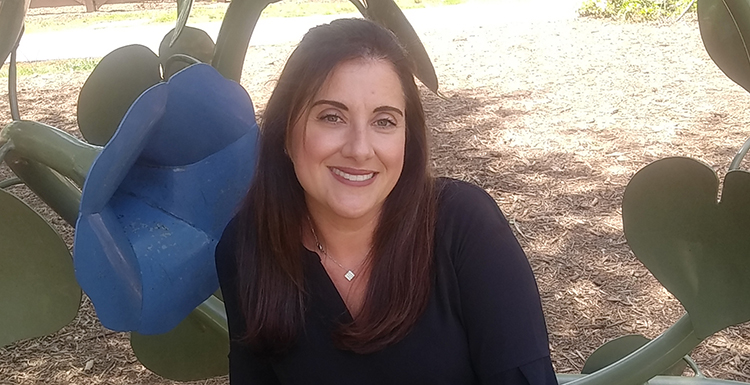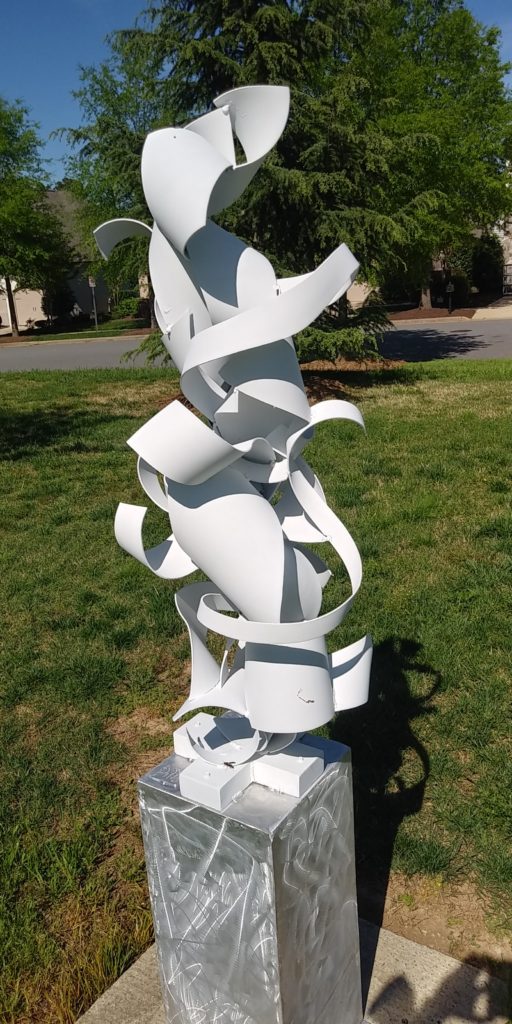
Marisa J. Pascucci
By Dave Yochum. Cornelius has more and more public art. Whether it’s a monumental piece, or whimsical and fun, public art encourages civic dialogue and an appreciation for another’s point of view.
Who can’t enjoy time spent with a child at the six-foot tall Humpty Dumpty sculpture of etched and cast aluminum and steel by Greensboro-based artist Eric Isbanioly?
Or taking pictures with Mark Twain in front of the Cornelius Public Library, courtesy of famed sculptor Jon Hair?
Public art is democratic art, not imposing, not shrouded in dim lights and hushed conversation.
In a world struggling to connect, public art is there to help, says Marisa J. Pascucci, the Antiquity resident who is curator-in-residence at the prestigious McColl Center for Art in Uptown Charlotte.
She helped the town array the pieces in the new “Beyond Walls” exhibit now open at Robbins Park. The park is a destination for not just sports and recreation, but visual and intellectual stimulation and understanding.
Art can reinforce and define community. She explains that driving into the center of Cornelius doesn’t happen without seeing a variety of pieces, from the Community Garden in Smithville to “Geyser,” an aluminum and steel piece by Harry McDaniel in front of the Arts Center in the Oak Street Mill.
All this in a town where the most prominent piece of public art for 100 years was a Confederate

8th Avocado by Jarod Charzewski
Soldier’s monument. The conversation about the cultural definition of Cornelius is doing a hard reset.
Pascucci says part of public art is creative placemaking: Making the streetscape more attractive.
Visual punctuation marks for people—and drivers—provide cues to stop and reflect or talk.
She said a public bench can be a piece of art, like Jim Gallucci’s “Morning Glory Whisper Bench” on permanent display in Robbins Park.
“You can have an ordinary bench or artist-created benches; instead of being a mass-produced functional piece, you can have an artist-created one,” she said, explaining that public art adds beauty to the built environment.
Public art also contributes to the economy.

White Water by Richard Pitts
Some people are born artists. Take Cathy Perry, who has two works on display at “Beyond Walls.”
She is a full-time sculptor in Lewisburg, Ky., whose work has sold for anywhere from $300 to $7,500. Her pieces can be an affirmation of positive feelings and experiences.
“I’m inspired by memories and traditions that were passed down from my mother and grandmother…my sculptures look for peace and harmony found within a garden and the tranquility that inspires a person to slow down,” she says.
The public art is a tiny part of the town’s $23 million annual budget, but it has a big impact. “Beyond Walls” costs about $10,000 a year. The winner of the “People’s Choice” award receives a $1,000 stipend.
The town sometimes buys pieces—like Humpty Dumpty—for permanent display.
“Beyond Walls” is an open air sculpture garden, on display from now until the end of January 2020. Vote for your favorite piece at cornelius.org/parc/PublicArt now through June 30, 2019 for the People’s Choice Award. The winning artist will be awarded a $1,000 cash prize.
There are seven sculptures in the 2019-20 show. Artists include Jarod Charzewski, Robert Doster, Scott Froschauer, Cathy Perry, Richard Pitts and Robert Porreca.




